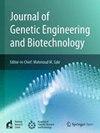Development and optimization of in vitro shoot regeneration in Physalis peruviana using cotyledon explants
IF 2.8
Q3 Biochemistry, Genetics and Molecular Biology
Journal of Genetic Engineering and Biotechnology
Pub Date : 2025-01-25
DOI:10.1016/j.jgeb.2025.100463
引用次数: 0
Abstract
The genetic improvement of Physalis peruviana L. faces important challenges because it is a recalcitrant species, which limits its use in breeding and conservation programs. In the present research, the objective was to develop an effective regeneration protocol using cotyledon cultures. For this purpose, the effects of zeatin (ZT) and meta-topoline (mT) at concentrations of 0, 0.5, 1.0 and 2.0 mg/L and the effects of several auxins, including indolbutyric acid (IBA), indolacetic acid (IAA), naphthaleneacetic acid (NAA) and 2.4-dichlorophenoxyacetic acid (2.4-D), on morphogenetic responses were evaluated. A maximum regeneration of 62.5 % was achieved with the combination of 2 mg/L ZT, 2 mg/L mT, and 0.5–1 mg/L IBA. For root formation, the best results were obtained with the combination of 2 mg/L ZT, 2 mg/L mT, and 1 mg/L NAA, reaching a maximum rate of 87.5 %. In conclusion, specific combinations of cytokinins and auxins can overcome the resistance of P. peruviana to regeneration and provide a solid basis for biotechnological applications such as genetic transformation and germplasm conservation.
利用青稞子叶外植体进行青稞离体再生的研究与优化
由于它是一种顽固性物种,限制了其在育种和保护计划中的应用,因此对其遗传改良面临着重要的挑战。在本研究中,目的是开发一个有效的再生方案,利用子叶培养。为此,研究了0、0.5、1.0和2.0 mg/L浓度的玉米素(ZT)和间topoline (mT)以及吲哚丁酸(IBA)、吲哚乙酸(IAA)、萘乙酸(NAA)和2.4-二氯苯氧乙酸(2.4-D)几种生长素对植物形态发生反应的影响。ZT用量为2 mg/L, mT用量为2 mg/L, IBA用量为0.5 ~ 1 mg/L,再生率为62.5%。以2 mg/L ZT、2 mg/L mT和1 mg/L NAA组合生根效果最好,生根率最高可达87.5%。综上所述,细胞分裂素和生长素的特异性组合可以克服紫杉树的再生抗性,为其遗传转化和种质资源保护等生物技术应用提供了坚实的基础。
本文章由计算机程序翻译,如有差异,请以英文原文为准。
求助全文
约1分钟内获得全文
求助全文
来源期刊

Journal of Genetic Engineering and Biotechnology
Biochemistry, Genetics and Molecular Biology-Biotechnology
CiteScore
5.70
自引率
5.70%
发文量
159
审稿时长
16 weeks
期刊介绍:
Journal of genetic engineering and biotechnology is devoted to rapid publication of full-length research papers that leads to significant contribution in advancing knowledge in genetic engineering and biotechnology and provide novel perspectives in this research area. JGEB includes all major themes related to genetic engineering and recombinant DNA. The area of interest of JGEB includes but not restricted to: •Plant genetics •Animal genetics •Bacterial enzymes •Agricultural Biotechnology, •Biochemistry, •Biophysics, •Bioinformatics, •Environmental Biotechnology, •Industrial Biotechnology, •Microbial biotechnology, •Medical Biotechnology, •Bioenergy, Biosafety, •Biosecurity, •Bioethics, •GMOS, •Genomic, •Proteomic JGEB accepts
 求助内容:
求助内容: 应助结果提醒方式:
应助结果提醒方式:


